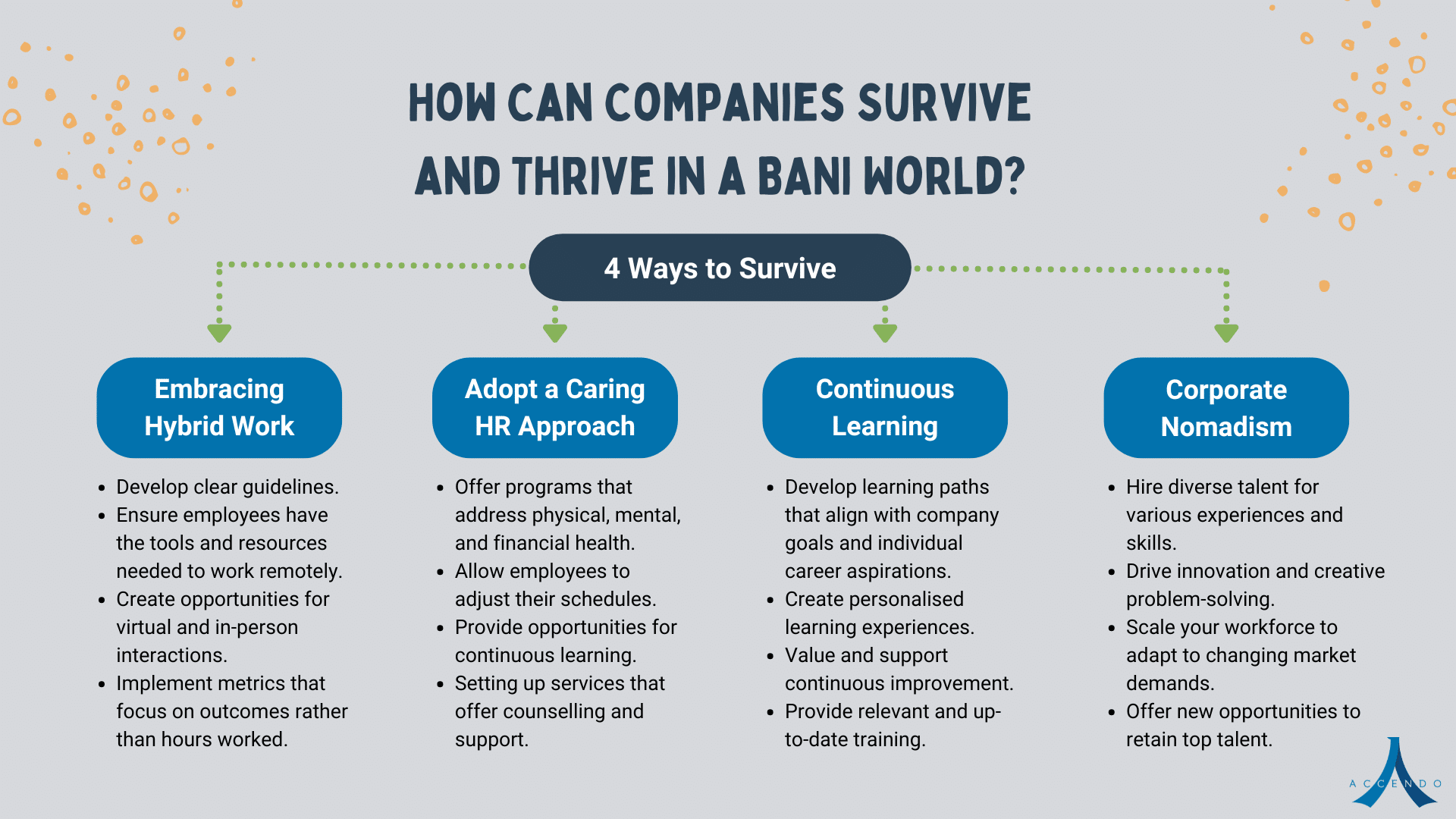Today’s ever-changing world has forced the business landscape to constantly evolve, and companies must adapt to survive. To navigate this dynamic environment, HR teams need to be aware of several key acronyms that capture the current challenges and opportunities they face. Our article explores these acronyms and how HR teams can prepare their talent acquisition and talent management strategies in a BANI (brittle, anxious, non-linear and incomprehensible) world.
Introduction
When we think of acronyms, we know that the common ones exist – ASAP, LOL, BRB, OMG and TGIF. Then there are TL; DR (Too Long; Didn’t Read) and WYSIWYG (What You See Is What You Get). In the realm of business today, there are three different kinds of acronyms – BANI, RUPT, and VUCA.
What are BANI, RUPT, and VUCA?
Today’s business environment is a baffling mix of BANI, RUPT, and VUCA. This triple threat throws all sorts of challenges at companies, demanding they be resilient, flexible, and always ready to adapt. Businesses must deal with rapid changes, unpredictable outcomes, and complex interconnections, all while managing the stress and anxiety these conditions bring.

- BANI stands for Brittle, Anxiety, Non-linear, and Incomprehensible. It reflects a world where systems that seem strong can break under pressure, constant uncertainty leads to stress, outcomes aren’t proportional to inputs, and the sheer volume of information can be overwhelming. Businesses need resilience to handle brittleness, support systems to manage anxiety, flexible planning to address non-linearity, and enhanced comprehension tools to manage incomprehensibility
- RUPT stands for Rapid, Unpredictable, Paradoxical, and Tangled. In the business world, RUPT describes environments where changes happen quickly, outcomes are hard to predict, situations are contradictory, and issues are deeply interconnected. This requires businesses to be extremely agile and quick to adapt to maintain a competitive edge.
- VUCA stands for Volatile, Uncertain, Complex, and Ambiguous. This framework highlights environments characterised by rapid changes, unpredictability, numerous interconnected variables, and a lack of clarity. Businesses operating under VUCA conditions need flexible strategies and adaptive planning to navigate the unpredictable and complex landscape successfully.
Making Sense of RUPT and VUCA in a BANI World
Understanding the principles of BANI, RUPT, and VUCA helps companies craft better strategies to survive and thrive in this wild and ever-changing landscape. Here’s what you need to know:
- To handle Brittleness, be quick to respond to changes (RUPT) and prepare for sudden disruptions (VUCA). This helps to build systems that can endure stress without breaking.
- To manage Anxiety, think creatively about contradictions (RUPT) and navigate unclear situations (VUCA). This creates a supportive environment that reduces employee stress.
- To tackle Non-linear outcomes, stay flexible (RUPT) and manage complex situations (VUCA). This helps to develop strategies that account for unpredictable results.
- To deal with Incomprehensibility or overwhelming information, use a broad, holistic approach (RUPT) and improve decision-making skills (VUCA). This helps to manage and understand large amounts of data effectively.
Combining these approaches enable companies to better navigate the complex and ever-changing business environment.
How Can Companies Survive and Thrive in a BANI World?
The COVID-19 pandemic and other recent global shake-ups have fast-forwarded our shift into a BANI world. HR leaders are dealing with high employee turnover, hybrid work demands, and the need for continuous reskilling and upskilling, especially where generative AI is concerned.
- The “Great Resignation” has seen unprecedented numbers of employees leaving their jobs, seeking better opportunities or more meaningful work.
- Quiet hiring sees critical roles being strategically filled by upskilling current employees or reallocating them to new roles, ensuring essential functions are covered while keeping recruitment costs low.
- Balancing remote and in-office work requires new policies, technology, and management approaches to ensure productivity and collaboration.
- Rapid technological advancements necessitate ongoing learning and development initiatives to keep pace with changing job requirements.
- Generative AI has taken over portions of work through task automation, providing data-driven insights, and improving decision-making processes to help businesses stay agile and innovative in a rapidly changing environment.
- Anxiety and stress levels have surged, making it crucial for HR to address mental health and maintain high levels of engagement.
As a result, HR teams must adopt flexible and adaptive strategies, which include:

Embracing Hybrid Work
The pandemic may have upended the global economy, but it has also ushered in a new era of working – hybrid working. Employees now expect to spend more time with family and pursue other goals outside of work. This implies that employees require more control over how they work and when they work.
To effectively manage hybrid work models, HR teams need to:
- Develop clear guidelines that balance flexibility with accountability.
- Ensure employees have access to the tools and resources needed to work efficiently from any location.
- Create opportunities for virtual and in-person interactions to maintain team cohesion and culture.
- Implement metrics that focus on outcomes rather than hours worked.
Adopt a Caring HR Approach
A caring HR Management approach is critical for any organisational success in this brittle and anxious world today. The global workforce is currently suffering from burnout and stress. As a result, millions of employees have either left the workplace or found other forms of employment elsewhere.
Putting employee well-being first means:
- Offering programs that address physical, mental, and financial health.
- Allowing employees to adjust their schedules to better manage personal and professional responsibilities.
- Providing continuous learning and growth opportunities to enhance job satisfaction and reduce burnout.
- Setting up services like Employee Assistance Programs that offer counselling and support for personal and professional issues.
Encourage Continuous Learning
The World Economic Forum’s Future of Jobs Report 2023 gives us a clear picture of the job market up to 2027. Nearly half of the skills employees use today will be disrupted by technology like AI and robotic process automation. This means 60% of employees will need new training, however, only half have access to the necessary opportunities.
The report also highlights the rising importance of continuous learning and online education as cost-effective ways for businesses to keep their employees’ skills up to date. Investing in reskilling and upskilling means:
- Developing learning paths that align with both organisational goals and individual career aspirations.
- Using digital platforms and AI to create personalised learning experiences.
- Fostering a culture where continuous improvement is valued and supported.
- Collaborating with educational institutions and industry partners to provide relevant and up-to-date training.
Leveraging Corporate Nomadism
Corporate nomadism is gaining significant traction in 2024, driven by technological advancements and the shift towards remote work. A corporate nomad is an individual who engages and participates in part-time geographically dispersed work and projects within the employer’s network.
The World Economic Forum’s discussion at Davos 2024 highlighted this trend, emphasising the increasing mobility of highly skilled employees who can work from anywhere, thanks to advancements in digital infrastructure and remote work policies. Utilising mobile talent can enhance organisational capabilities by:
- Accessing a wider range of skills and experiences by hiring remote employees from different geographical locations.
- Bringing diverse perspectives that drive innovation and creative problem-solving.
- Quickly adapting to changing market demands by scaling the workforce to meet these demands.
- Offering flexibility and new opportunities to retain top talent who seek varied experiences and work-life balance.
What Does This Mean for You?
At the end of the day, we all know that the world is constantly changing. We’re now living in the age of digital chaos where the world is going against the traditional way of things in a radical and almost violent manner. It has become a BANI world. And organisations need to rise to the challenge of creating environments that win in the marketplace. Business leaders must be fearless in handling the immense challenges that they face today while taking steps to ensure the smooth execution of their talent strategies.
Page Contents






